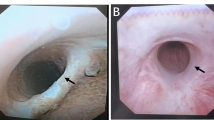Abstract
Objective
This report presents the results of a randomized prospective study comparing synchronous transurethral cystolitholapaxy and transurethral resection of the prostate (TURP) with transurethral cystolitholapaxy plus medical treatment for benign prostatic hyperplasia (BPH) in patients with concomitant vesical stone(s) and BPH.
Patients and methods
The study included 100 patients with bladder stone(s) < 2.5 cm associated with BPH. Eligible patients were divided randomly into two groups: group I (n = 50 patients) underwent simultaneous transurethral cystolitholapaxy and TURP, and group II (n = 50 patients) underwent transurethral cystolitholapaxy and received postoperative tamsulosin plus finasteride.
Results
The mean follow-up was 20.1 ± 5.3 months. No statistically significant differences were found between the 2 groups regarding the preoperative parameters (age, prostatic volume, bladder stone characteristics, prostate-specific antigen level, International Prostate Symptom Score, peak urinary flow rate, and post-void residual urine volume). Both groups experienced statistically significant postoperative improvement in IPSS, post-void residual (PVR) urine volume, and peak flow rate compared with the preoperative parameters (P < 0.001 for all parameters). However, patients in group 1 had a more pronounced improvement (P < 0.001 for all parameters). Thus, 15 patients in group 2 underwent TURP during follow-up. PVR urine and prostate volume predicted the failure of medical therapy and the need for TURP.
Conclusion
Synchronous transurethral cystolitholapaxy and TURP revealed better results than transurethral cytolitholapaxy plus medical therapy. Cystolitholapaxy without TURP should not be indicated especially in patients with significant PVR urine volumes and larger prostates.
Similar content being viewed by others
References
Lee SWH, Chan EMC, Lai YK (2017) The global burden of lower urinary tract symptoms suggestive of benign prostatic hyperplasia: a systematic review and meta-analysis. Sci Rep 7(1):1–10
Abrams P, Chapple C, Khoury S, Roehrborn C, de la Rosette J (2009) International Scientific Committee. Evaluation and treatment of lower urinary tract symptoms in older men. J Urol 181:1779–1787
Oelke M, Bachmann A, Descazeaud A et al (2013) Guidelines on the treatment and follow-up of non-neurogenic male lower urinary tract symptoms including benign prostatic obstruction. Eur Urol 64:118–140
Jiwrajka M, Yaxley W, Perera M et al (2018) Review and update of benign prostatic hyperplasia in general practice. Aust J Gen Pract 47:471–475
Metwally AH, Sherief MH, Elkoushy MA (2016) Safety and efficacy of cystoscopically guided percutaneous suprapubic cystolitholapaxy without fluoroscopic guidance. Arab J Urol 14(3):211–215
Li W-M, Chou Y-H, Li C-C (2009) Local factors compared with systemic factors in the formation of bladder uric acid stones. Urol Int 82:48–52
Grosse H (1990) Frequency, localization and associated disorders in urinary calculi. Analysis of 1671 autopsies in urolithiasis. Z Urol Nephrol 83(9):469–474
Childs MA, Mynderse LA, Rangel LJ et al (2013) Pathogenesis of bladder calculi in the presence of urinary stasis. J Urol 189(4):1347–1351
Shah HN, Hegde SS, Shah JN et al (2007) Simultaneous transurethral cystolithotripsy with holmium laser enucleation of the prostate: a prospective feasibility study and review of literature. BJU Int 99(3):595–600
Krambeck AE, Handa SE, Lingeman JE (2010) Experience with more than 1000 holmium laser prostate enucleations for benign prostatic hyperplasia. J Urol 183(3):1105–1109
Gross AJ, Netsch C, Knipper S et al (2013) Complications and early postoperative outcome in 1080 patients after thulium vapoenucleation of the prostate: results at a single institution. Eur Urol 63(5):859–867
Takasaki E, Suzuki T, Honda M et al (1995) Chemical compositions of 300 lower urinary tract calculi and associated disorders in the urinary tract. Urol Int 54(2):89–94
O’Connor RC, Laven BA, Bales GT, Gerber GS (2002) Nonsurgical management of benign prostatic hyperplasia in men with bladder calculi. Urology 60(2):288–291
McVary KT, Roehrborn CG, Avins AL et al (2011) Update on AUA guideline on the management of benign prostatic hyperplasia. J Urol 185(5):1793–1803
Philippou P, Volanis D, Kariotis I et al (2011) Prospective comparative study of endoscopic management of bladder lithiasis: is prostate surgery a necessary adjunct? Urology 78:43–47
Millan-Rodriguez F, Izquierdo-Latorre F, Montlleo-Gonzalez M et al (2005) Treatment of bladder stones without associated prostate surgery: results of a prospective study. Urology 66:505–509
Yoshida T, Kinoshita H, Nakamoto T, Yanishi M, Sugi M, Murota T et al (2015) Conservative treatment for benign prostatic hyperplasia in patients with bladder stones. Urology 86(3):450–453
Author information
Authors and Affiliations
Contributions
AMH: protocol, data collection, and manuscript writing. MAA: data analysis. AFA: manuscript editing. OMA: data collection. AAA: manuscript writing. GAA: data collection.
Corresponding author
Ethics declarations
Conflict of interest
The authors had no conflicts of interest related to this publication.
Informed consent
Informed written consent was taken from all participants in the study
Additional information
Publisher's Note
Springer Nature remains neutral with regard to jurisdictional claims in published maps and institutional affiliations.
Rights and permissions
About this article
Cite this article
Hasan, A.M., AbdelRazek, M., Ali, A.F. et al. Synchronous transurethral cystolitholapaxy and TURP reveals better results than transurethral cystolitholapaxy plus medical therapy for BPH: a randomized prospective study on 100 patients with concomitant urinary bladder stone(s) and BPH. World J Urol 40, 483–487 (2022). https://doi.org/10.1007/s00345-021-03882-4
Received:
Accepted:
Published:
Issue Date:
DOI: https://doi.org/10.1007/s00345-021-03882-4



